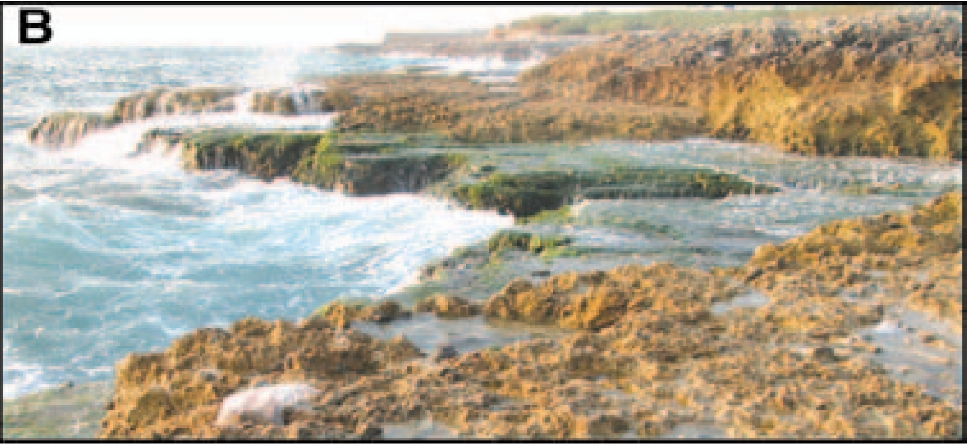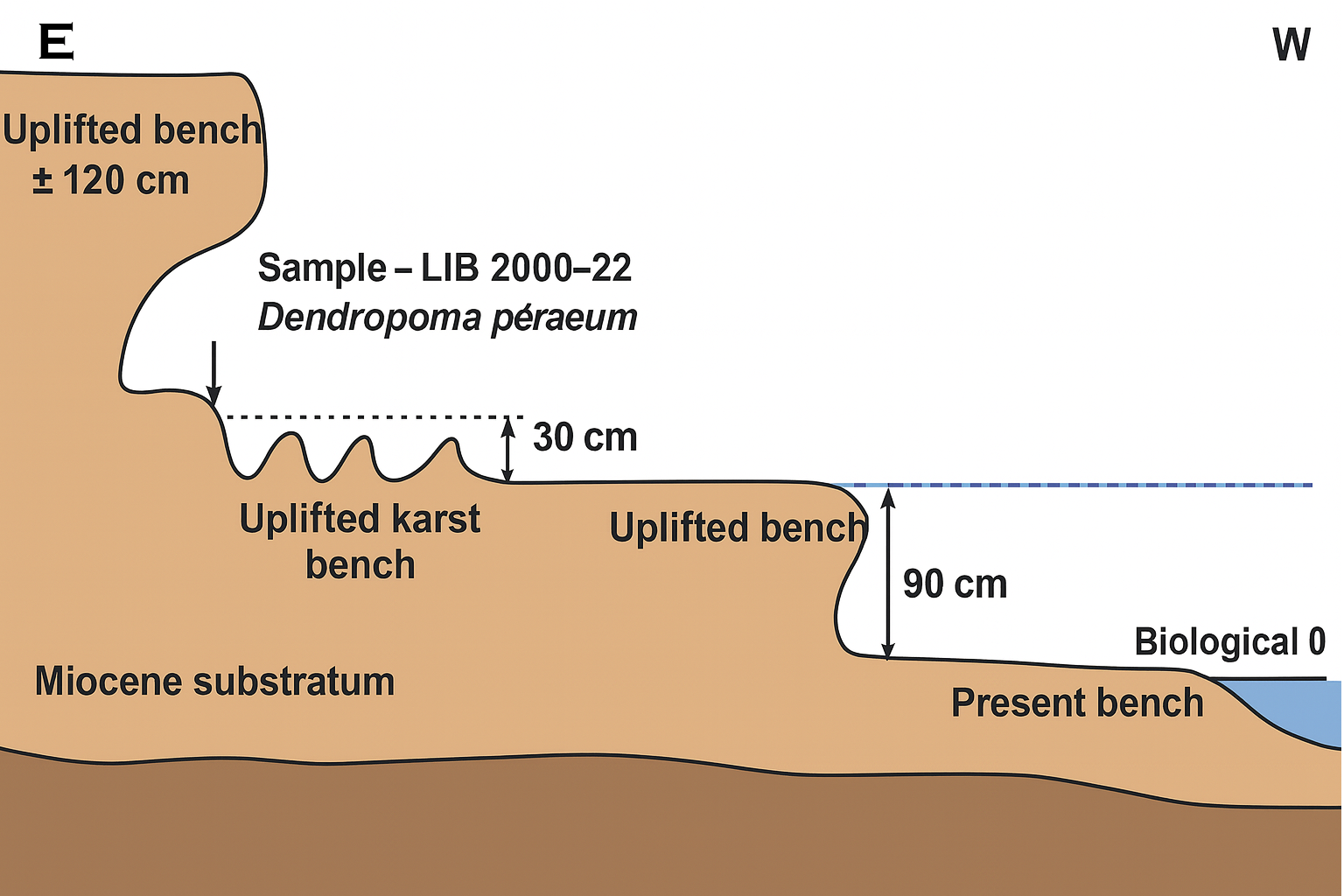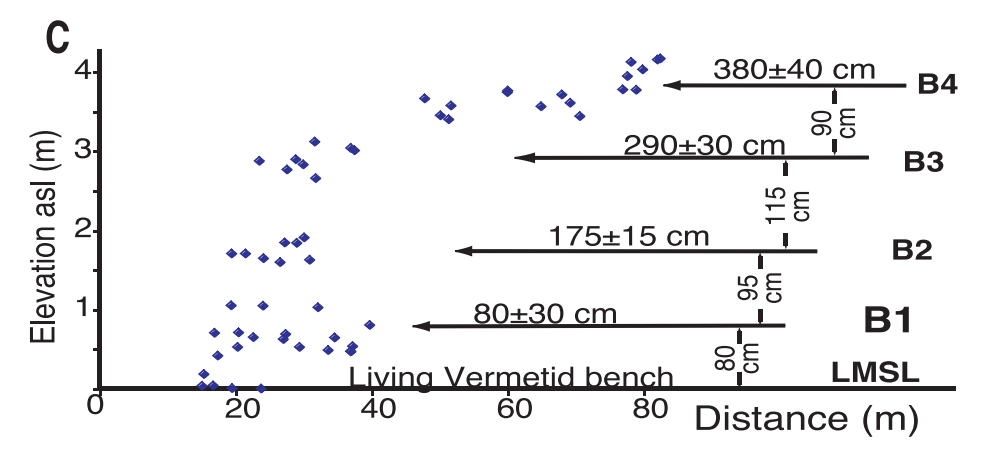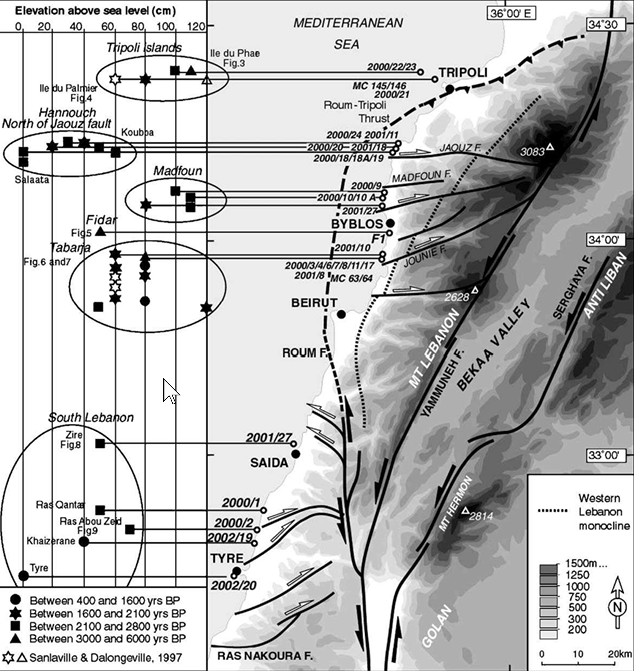Tabarja Benches
 Figure 2B
Figure 2BUplifted, karst-pitted vermetid benches near Tabarja.
Elias et al (2007)
Elias et al. (2007) examined
uplifted benches on the Lebanese coast between Sarafand and
Tripolis, including areas near
Tabarja (~20 km NE of Beirut). They estimated
that ~80 cm of uplift occurred on the lowest bench (B1) in the
6th century CE. Deep-towed sonar data collected offshore showed
fresh west-facing fault scarps cutting across the otherwise
smooth seafloor, which they associated with seismic activity
along the newly identified offshore Mount Lebanon Thrust Fault
system. They concluded that ~100–150 km of this fault ruptured
in 551 CE, generating an earthquake with a moment magnitude
(Mw) of ~7.5.
Previous researchers had suggested that elevated fossil benches
along the Lebanese coast (mostly between Beirut and Tripolis)
were formed by past earthquake activity.
Morhange et al. (2006) used
radiocarbon dating of fossil
vermetids on the tops
of these benches to determine when they were last in the subtidal
zone (approximately mean sea level). By integrating these dates
with seismic evidence,
Elias et al. (2007) concluded
that the well-documented 551 Beirut earthquake caused 80 ± 30 cm
of uplift of the lowest bench (B1) during that seismic event.
 Figure DR7
Figure DR7Death age probability distribution of 17, 14C calibrated Vermetid death ages on
"B1" bench between Beirut and Palmier Island (sum probability, normalized to unit height).
Elias et al (2007) supplemental
Elias et al (2007)
discovered an ~160 km. long offshore thrust system in the process of collecting and analyzing their geophysical data. They termed this new thrust fault system the
the Mount Lebanon Thrust.
 Figure 2a
Figure 2aBathymetric map of proximal Lebanese offshore.
-
Offshore
- Bold red lines are "fresh" seafloor seismic breaks.
- Green line is survey path.
- Box b indicates location of sonar image in Figure 3 above.
Onshore- Orange lines are locations of elevated benches
- Red dots are sample locations for radiocarbon dating.
JW: Image is rotated compared to original publication -
Elias et al (2007)
The deep towed sonar data showed fresh west facing seismogenic fault scarps on the smooth ocean floor which allowed them to map and characterize this thrust system. In commenting on the fault scarps, they stated that
given their geomorphic resemblance to sub-aerial, seismic dip-slip ruptures, and their position near the foot of cumulative bathymetric escarpments, the seismic origin of such submarine breaks is not in doubt, although assessing whether they result from one or several earthquakes will require further investigation.
 Figure 3
Figure 3Seafloor seismic rupture. Sidescan sonar image of "fresh" seismic rupture along base of continental slope west of Damour (box "b" in Fig. 2A). Note sinuous, segmented trace, west-facing main scarp, and smaller parallel scarps on top of east (hanging) wall and away from main scarp base on footwall. Dark shades mark high backscatter. Insonification from top (west).
Elias et al (2007)
They later added that "direct dating of the sea-floor scarps will provide the ultimate proof". They noted that their survey "showed no evidence of submarine landslides except for small-scale slump scars and rockslides on or at the base of steep slopes south of Damour and near Batroun" concluding that it was "possible to rule out the occurrence of a large local submarine landslide as potential sources of historical tsunamis [e.g. in 551 CE] along the Lebanese coast." This last conclusion does not seem justified given the limited amount of side scan sonar data they collected. Further, the textual sources for the 551 CE Beirut Quake spoke of an initial ebbing of the sea which suggests that the tsunami was caused by a large submarine landslide. Nonetheless, the geographic coincidence of the stretch of coast exhibiting uplifted benches with the observed areal extent of submarine fault scarps appears to confirm that the Mount Lebanon Thrust fault was the source of large ancient earthquakes and tsunamis along the coast.
| Effect | Location | Image(s) | Description |
|---|---|---|---|
| Coastal Uplift | Lebanese Coast |

 Figure 3
Figure 3On the northern part of IIe du Phare (Tripoli), marks of a double raised bench have been preserved. The lowest step, at approx. +1 m (above present MSL), comprises Dendropoma dated 2630 ± 35 BP (403-265 cal. BC). The outer part of the upper step, at approx. +1.2 m, has been dissected by erosion, but on the inner part, that corresponds to the base of a tidal notch, a thin cover of in situ Dendropoma petraeum shells have been collected and dated 5975 ± 40 BP (4514-4339 cal. BC). Click on image to open in a new tab Morhange et al. (2006b) |
|
- Earthquake Environmental Effects (ESI 2007)
| Effect | Location | Image(s) | Description | Intensity |
|---|---|---|---|---|
| Coastal Uplift | Lebanese Coast |

 Figure 3
Figure 3On the northern part of IIe du Phare (Tripoli), marks of a double raised bench have been preserved. The lowest step, at approx. +1 m (above present MSL), comprises Dendropoma dated 2630 ± 35 BP (403-265 cal. BC). The outer part of the upper step, at approx. +1.2 m, has been dissected by erosion, but on the inner part, that corresponds to the base of a tidal notch, a thin cover of in situ Dendropoma petraeum shells have been collected and dated 5975 ± 40 BP (4514-4339 cal. BC). Click on image to open in a new tab Morhange et al. (2006b) |
|
IX |
 Figure 2C
Figure 2CProjected total station measurements of bench elevations relative to LMSL (living vermetid surface in swash zone). Note signifi cant scatter in elevation measurements on fossil levels, particularly B1 and B4, likely because of sub-levels with rounded edges and of irregularities due to deep pitting by microkarst.
Elias et al (2007)
Elias et al (2007) estimated a moment magnitude (Mw) of ~7.4-7.6 for the 551 CE Beirut Quake and offered the following discussion:
To raise the Tabarja trottoirs [benches] 80 ± 30 cm above the LMSL [Local Mean Sea Level], simple dislocation modeling in an elastic half-space (Okada, 1985) requires 1.5-3 m of seismic slip on these ramps, assuming they dip -45° eastward in the upper 20 km of the crust (Data Repository item DR8). Such slip amounts are consistent with the estimated magnitude of the A.D. 551 earthquake, and sufficient to account for the tsunami observed. Historical evidence combined with the extent of vermetid death in the sixth century A.D. implies a rupture length of at least -100 km, and possibly up to 150 km if the Rankine-Aabdeh lateral ramp was involved (Figs. 1 and 4), as suggested by two ages on Palmier Island (Table DR6). For such rupture lengths on thrust faults, empirical scaling laws predict an Mw of ~7.4-7.6 (Wells and Coppersmith, 1994), consistent with macroseismic estimates. Because strike-slip motion on the Yammouneh fault has been shown to produce only small local uplift (less than ~1 m in ~10,000 yr; Daeron et al., 2005), the inference that events on this fault might raise shorelines north of Beirut (Morhange et al., 2006) can be safely ruled out. The coastal 14C vermetid ages confirm that the great A.D. 1202 earthquake, for instance, produced no uplift along the Lebanese shoreline. That benches offshore Tripoli are older than the seventh century A.D. in fact excludes the possibility that any of the earthquakes of the eleventh to fourteenth century A.D. sequence, including the A.D. 1063 event, ruptured the offshore Mount Lebanon thrust system. Hence, the destruction of Tripoli and Arqa by the latter earthquake may have been caused by slip on the Aakkar and/or Tripoli thrusts (Fig. 4).
Figure 4
Most likely sources of A.D. 551 (open star—inferred epicenter, this study) and other large historical earthquakes in Lebanon (modifi ed from Daëron et al., 2005). Colored patches enclose areas where macroseismic intensities >VIII were reported. Blue color corresponds to A.D. 551. (VIII isoseismal from Sieberg, 1932).
Elias et al (2007)
Source - Wells and Coppersmith (1994)
| Variable | Input | Units | Notes |
|---|---|---|---|
| km. | Fault Break | ||
| km. | Fault Break | ||
| Variable | Output - not considering a Site Effect | Units | Notes |
| unitless | Moment Magnitude for Min. Rupture Length | ||
| unitless | Moment Magnitude for Max. Rupture Length |
Source - Wells and Coppersmith (1994)
| Variable | Input | Units | Notes |
|---|---|---|---|
| cm. | Seismic slip on the ramps | ||
| cm. | Seismic slip on the ramps | ||
| Variable | Output - not considering a Site Effect | Units | Notes |
| unitless | Moment Magnitude for Avg. Displacement | ||
| unitless | Moment Magnitude for Max. Displacement |
Daëron, M., et al. (2005). "Sources of the large A.D. 1202 and 1759 Near East earthquakes." Geology 33(7): 529-532.
Elias, A., et al. (2007). "Active thrusting offshore Mount Lebanon: Source of the tsunamigenic A.D. 551 Beirut-Tripoli earthquake." Geology 35(8): 755-758.
Morhange, C., et al. (2006). "Late Holocene relative sea-level changes in Lebanon, Eastern Mediterranean." Marine Geology 230(1): 99-114.
Okada, Y. (1985). "Surface deformation due to shear and tensile faults in a half-space." Bulletin of the Seismological Society of America 75: 1135-1154.
Sanlaville P, Dalongeville R, Bernier P, Evin J (1997) The Syrian coast: a model of Holocene coastal evolution. J Coast Res 13(2): 385–396 - JSTOR
Sarieddine, K. (2022). Seismic Interpretation and Analysis of the Messinian Salt system Offshore Lebanon. Msc Thesis, American University of Beirut. 121p
SHALIMAR Oceanographic cruise 27/09/2003 - 26/10/2003 Data Page
Sivan, D., Schattner, U., Morhange, C., Boaretto, E. (2010). "What can a sessile mollusk tell about neotectonics?" Earth and Planetary Science Letters 296(3): 451-458.


